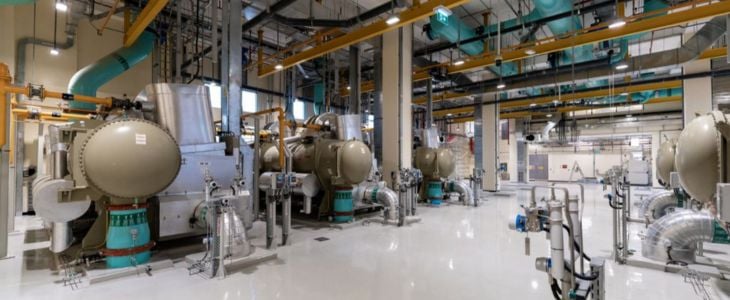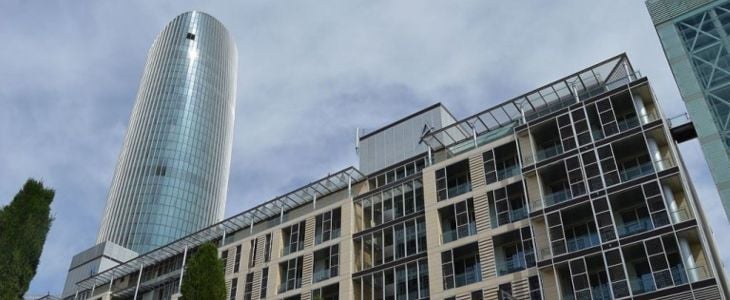Unlocking the advantages of district cooling may hold the key to embracing the future of cooling in a more sustainable and cost-efficient way.
As our world grapples with the ever-increasing demands for cooling and the challenges of climate change, the advantages of district cooling as opposed to a conventional cooling system have emerged as a promising solution.
This approach has already been embraced by a myriad of organizations, such as the International Energy Association, which puts the focus on the transition towards district energy to achieve the Net Zero Emissions by 2050 Scenario. The same organization cites this approach as a way to tap into renewable heat sources, integrate secondary heat sources and develop high-efficiency infrastructure.
This and other affirmations are mirrored by the actions of thousands of both public and private operations turning to the advantages of district cooling. Such is the case of the Dubai Integrated Strategy 2030 (or DIES2030), which aims to secure a sustainable supply of energy in the Emirate by putting district cooling at the forefront of energy initiatives.
But, what exactly is district cooling and what are considered as the main advantages of district cooling as opposed to the conventional cooling system? Keep reading to find out.
What is district cooling
District cooling represents a centralized approach to the cooling system which is able to provide chilled water (or another cooling medium) to multiple buildings or facilities within a specific area
As such, the district cooling process typically includes the following elements:
- A central cooling plant, which generates chilled water or another cooling medium using various methods, such as absorption chillers or electric chillers. The plant is usually located away from the individual buildings it serves.
- A distribution network, where chilled water is circulated through a network of underground pipes or other distribution infrastructure to transport the cooling energy to various buildings.
District cooling is particularly common in densely populated urban areas, commercial districts, and industrial parks, where many buildings require cooling services.
It offers an alternative to a conventional cooling system, promoting more efficient resource utilization and contributing to sustainable urban development. As such, it has become a fundamental option among sustainable cooling options.
The advantages of district cooling
District cooling offers numerous advantages, making it an attractive choice for providing cooling services to multiple buildings and urban areas. Here are some of the key advantages of district cooling:
Energy efficiency
District cooling systems are designed for high energy efficiency, as centralizing the cooling generation allows for economies of scale and improved system optimization.
In fact, the centralized cooling generation allows for the use of large, efficient equipment and optimized operations. Such is the case of the use of highly-effient industrial chillers, which add their own share of additional benefits to the advantages of district cooling mentioned in this article. All in all, this approach results in reduced energy consumption and lower greenhouse gas emissions.

Cost savings
District cooling can potentially reduce cooling costs because of the centralization of equipment and operations, which can lead to lower maintenance and operational expenses.
At the same time, it reduces the need for individual building cooling systems, which can be expensive to install and maintain.
Scalability
Yet another benefit in the list of the advantages of district cooling is these are designed to be easily expandable. As new buildings are added to the serviced area or cooling demand increases, the central plant can be upgraded to accommodate the growing needs without significant disruptions.
Reduced maintenance
When considering the advantages of district cooling, many cite how building owners and operators can benefit from reduced maintenance and equipment replacement costs because they no longer need to manage their own cooling systems. In other words, it’s the central cooling provider which is responsible for maintaining the infrastructure and equipment.
Environmental sustainability
Among the key advantages of district cooling is that these systems have the potential to reduce greenhouse gas emissions and promote environmental sustainability.
On the one hand, they can easily integrate renewable energy sources (such as solar, wind, and geothermal energy) thus reducing or eliminating the need for fossil fuels.
At the same time, these systems can be more environmentally friendly than a conventional cooling system as they often use more efficient equipment and have the potential to incorporate renewable energy sources.
What’s more, these systems can be more water-efficient as they recycle and reuse water for cooling purposes. As such, they reduce the need for individual cooling towers, which can be significant water consumers.
Reliability
District cooling systems often offer higher reliability compared to individual, conventional cooling systems. In the face of extreme weather events or natural disasters, district cooling systems may provide more robust and resilient cooling solutions, minimizing service disruptions. This can be extremely important for critical facilities and businesses that rely on uninterrupted cooling.
The enhanced reliability among the advantages of district cooling is particularly true when it comes to systems that incorporate redundancy and backup options, ensuring continuous cooling even in case of equipment failures or emergencies.
A comparison: the conventional cooling system vs. the advantages of district cooling
For the purpose of this comparison, let’s define a conventional cooling system as a structure that typically involves standalone air conditioning units, chillers, or cooling towers installed in individual buildings, so that each building operates its cooling system independently.
Here thus lies the key difference with the advantages of district cooling, a centralized approach that uses a cooling plant to produce chilled water or cooling medium for multiple buildings within a district or urban area.
From this crucial difference thus originates a series of fundamental distinctions between the two approaches.

Energy efficiency
First and foremost, let’s look at energy efficiency. Conventional cooling systems generally present a lower energy efficiency, as individual systems may vary in design, size, and maintenance practices, leading to suboptimal performance. In fact, it’s estimated that this approach creates 50% to 70% of the peak electricity demand in buildings at a very high cost.
On the other hand, centralized plants are able to incorporate high-efficiency equipment and optimize operations, resulting in significantly better energy efficiency. In fact, estimates see almost 40% of energy efficiency improvements when it comes to the advantages of district cooling in this area.
Costs
In a conventional cooling system, building owners are responsible for the upfront costs, maintenance, and repairs of their individual cooling systems, which can be expensive.
On the other hand, the implementation of a district cooling system often leads to cost savings for both providers and customers due to economies of scale and shared infrastructure. In fact, it’s estimated that costs can be reduced between 20% to 35% compared to conventional cooling systems.
Environmental impact
The use of conventional cooling systems typically presents a higher environmental impact, originating in factors such as energy inefficiencies and the potential use of older, less eco-friendly equipment.
On the other hand, among the key advantages of district cooling is they present a more environmentally friendly approach to cooling, as they can integrate renewable energy sources, waste heat recovery technologies, and other sustainable practices.
Maintenance and reliability
In conventional cooling systems, building owners are responsible for maintenance, which can vary in quality and timeliness, leading to potential downtime.
On the other hand, one of the key advantages of district cooling is that its centralized approach usually means equipment is maintained to high standards, ensuring better reliability and reduced downtime.
At ARANER, we’re committed to providing reliable, cost-efficient and sustainable thermal engineering. This is why we’ve become a leading district cooling company able to design, manufacture and implement cutting-edge district cooling systems that adapt to each project’s needs.
If you’re looking for a reliable partner to experience the advantages of district cooling in your project, look no further. Get in touch with our team and learn more about how we can help you.










